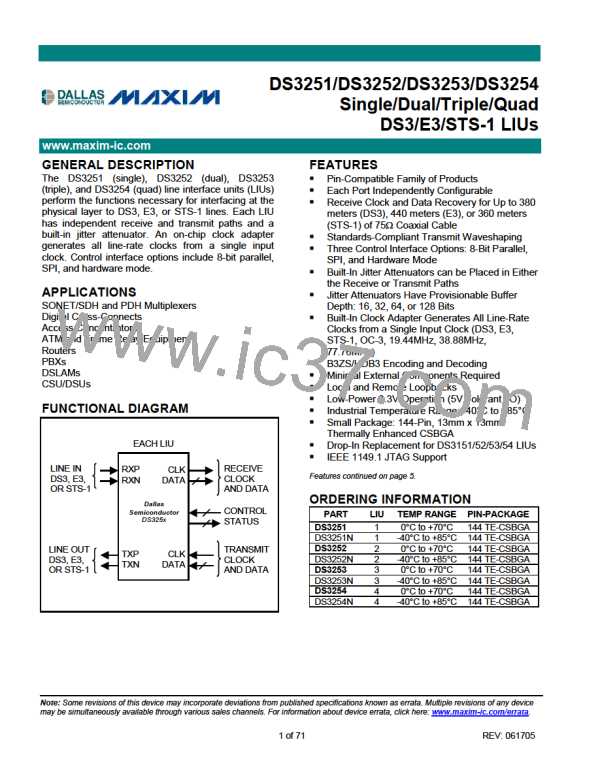DS3251/DS3252/DS3253/DS3254
FEATURES (CONTINUED)
Receiver
Cꢀ AGC/equalizer block handles from 0 to 15dB of cable loss
Cꢀ Loss-of-lock (LOL) PLL status indication
Cꢀ Interfaces directly to a DSX monitor signal (~20dB flat loss) using built-in preamp
Cꢀ Digital and analog loss-of-signal (LOS) detectors (ANSI T1.231 and ITU G.775)
Cꢀ Optional B3ZS/HDB3 decoder
Cꢀ Line-code violation output pin and counter
Cꢀ Binary or bipolar framer interface
Cꢀ On-board 215 - 1 and 223 - 1 PRBS detector
Cꢀ Clock inversion for glueless interfacing
Cꢀ Tri-state clock and data outputs support protection switching applications
Cꢀ Per-channel power-down control
Transmitter
Cꢀ Binary or bipolar framer interface
Cꢀ Gapped clock capable up to 51.84MHz
Cꢀ Wide 50 M 20% transmit clock duty cycle
Cꢀ Clock inversion for glueless interfacing
Cꢀ Optional B3ZS/HDB3 encoder
Cꢀ On-board 215 - 1 and 223 - 1 PRBS generator
Cꢀ Complete DS3 AIS generator (ANSI T1.107)
Cꢀ Unframed all-ones generator (E3 AIS)
Cꢀ Line build-out (LBO) control
Cꢀ Tri-state line driver outputs support protection switching applications
Cꢀ Per-channel power-down control
Cꢀ Output driver monitor
Jitter Attenuator
Cꢀ On-chip crystal-less jitter attenuator
Cꢀ Meets all applicable ANSI, ITU, ETSI and Telcordia jitter transfer and output jitter requirements
Cꢀ Can be placed in the transmit path, receive path or disabled
Cꢀ Selectable FIFO depth: 16, 32, 64 or 128 bits
Cꢀ Overflow and underflow status indications
Clock Adapter
Cꢀ Operates from a single DS3, E3, STS-1, 19.44 MHz, 38.88 MHz, or 77.76 MHz master clock
Cꢀ Synthesizes clock rates that are not provided externally
Cꢀ Use of common system timing frequencies such as 19.44 MHz eliminates the need for any local oscillators,
reduces cost and board space
Cꢀ Very small jitter gain and intrinsic jitter generation
Cꢀ Optionally provides synthesized clocks on output pins for use by neighboring components, such as framers or
mappers
Parallel CPU Interface
Cꢀ Multiplexed or nonmultiplexed 8-bit interface
Cꢀ Configurable for Intel mode (CS, WR, RD) or Motorola mode (CS, DS, R/W)
SPI CPU Interface
Cꢀ Operation up to 10 Mbit/s
Cꢀ Burst mode for multi-byte read and write accesses
Cꢀ Programmable clock polarity and phase
Cꢀ Half-duplex operation gives option to tie SDI and SDO together externally to reduce wire count
5 of 71

 DALLAS [ DALLAS SEMICONDUCTOR ]
DALLAS [ DALLAS SEMICONDUCTOR ]